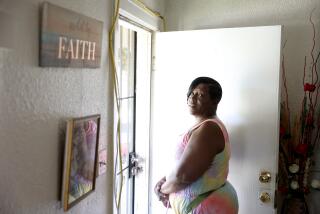FOSTER CHILDREN : Prevention Is Possible; Reform Is ‘Doable’
The cries of children at risk should be answered before they become screams of pain. What can be done to reform the system that too frequently compounds children’s suffering?
“We spend an obscene amount to maintain kids” in foster care, says Brian Cahill, director of the nonprofit Hathaway Children’s Services. “We don’t spend a dime on the front end, on prevention.”
Prevention worked for Casey, a young mother of six. Sexually molested and beaten as a child, she now found herself beating her own children. Her life, she now says, was “pure chaos,” and she tried to kill herself.
The school nurse saw the trouble signs and recommended that Casey seek help. Casey called a neighborhood center run by the Children’s Bureau, a nonprofit agency. Two social workers came out: one for her, another for the children.
The social workers told Casey where she could find ongoing programs that would help her and the kids. They didn’t impose the programs, just encouraged her to take the initiative in breaking the cycle of abuse.
Prevention saved one family. It also saved the county from taking on the burden of caring for six more children. Casey, who dropped out of school in seventh grade, is now studying for college entrance. She hopes to become a social worker.
Prevention is “doable,” says Children’s Bureau Director Judy Nelson. Reform of the system is doable, too. Here are 17 things that government and citizens can do:
1. Pour money into prevention. Drug counseling and parenting classes are crucial to prevent abuse and for every $1 spent in family preservation services, $1.50 is saved in foster care.
2. Provide continuity of care. Do everything possible to keep children from being bounced from foster home to foster home, social worker to social worker. Give each child one person who will be responsible for his or her case.
3. Monitor children carefully and frequently. Face-to-face visits are a child’s lifeline.
4. Lower caseloads. If social workers are overwhelmed, children suffer.
5. Create a comprehensive, objective system for evaluating children and the risks they face. The current haphazard evaluations allow too many crucial judgments to be subjective.
6. Build a “child-friendly” Dependency Court to replace the current facility shared with criminal courts. Streamline judicial procedures and initiate mediation to resolve disputes out of court where possible.
7. Provide independent legal representation for children in custody. Court-appointed lawyers cannot represent children’s interests when they are simultaneously representing the county. Foster parents should also be permitted to testify in court, a right and responsibility currently denied them.
8. Explain to children what is happening in a language they can understand.
9. Enlist citizens to become volunteer advocates for children in Dependency Court. The city of Los Angeles has an innovative child advocacy program, CASA.
10. Coordinate foster care with schools, as in the innovative Foster Youth Services program in the Sacramento public schools.
11. Provide each child with a “medical passport” to give continuity of medical care, especially for drug babies.
12. Base program funding for children on their needs, not on outdated formulas and partisan politics. Foster-care funding must not be capped in Washington. Federal family maintenance funding should also be open-ended. This will save money in the long run.
13. Bring new leadership and vision into the county’s Department of Children’s Services. California has some of the best minds in this field; they should be enlisted.
14. Stop officials in the state and county from throwing brickbats at each other. Agency directors should sit down together and cooperate on a plan to make the county comply with state mandates--and provide enough money to do it.
15. Create a public-private partnership for funding foster care. The corporate sector could initiate a major fund drive to raise millions for children at risk.
16. Enlist Hollywood to dramatize the needs of foster children and create programming that will help families deal with abuse rather than stimulate violence.
17. Last, and most important, stop the cycle of children having children. Provide perinatal care to every mother and child. When pregnant women test positive for abusive substances, give them immediate drug counseling. Last year, 2,400 drug babies were born in Los Angeles County. Their suffering is unimaginable, and they are overwhelming the system.
More to Read
Sign up for Essential California
The most important California stories and recommendations in your inbox every morning.
You may occasionally receive promotional content from the Los Angeles Times.










